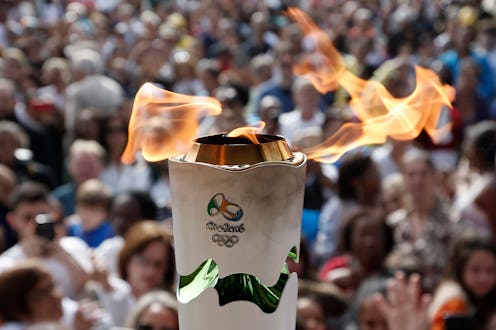News
The Olympics Work Hard To Keep The Fire Burning
The Olympic flame is one of the Games' most instantly recognizable symbols. Despite its size — and dare I say it, complete vulnerability — it embodies a massive amount of meaning and tradition, making it a prime target for anyone objecting to the Games. Protesters were reportedly able to extinguish the Olympic torch Wednesday as it was carried through the streets of Angra dos Reis in the final stretch of its journey to Rio. But while Rio's officials may be having a hard time keeping the Olympic torch lit, the official flame of the Summer Olympic Games is kept continually burning.
It should go without saying that Olympic flames are special. No ordinary match or lighter will do when it comes to lighting the Olympic torch. Like those before it, the Olympic flame for the 2016 Rio Games was lit in April during an official ceremony at the temple of Hera in Greece using the sun and a parabolic mirror. According to Olympic officials, the method and location used for sparking the flame are meant to ensure its "purity" and emphasize the "profound connection" between the ancient and modern Olympic Games.
Tradition dictates that the flame sparked at Hera be kept continuously burning. That means keeping it ignited all the way to the very end of the Games, throughout the torch's cross-country relay to the opening ceremony and during every athletic competition. It's a tall order, but officials don't expect the torch to be the flame's single source.
According to Rio spokesman Philip Wilkinson, Olympic officials set aside eight lanterns with backup flames drawn from the one lit in Greece. "The torch often goes out and is relit," Wilkinson told The Guardian. "The flame is never extinguished." Flames are reportedly housed in high-tech miner's lamps, which allows officials to ensure there is always a source of the official Olympic flame available to re-light the torch. The lanterns also allow the flame to travel long distances via private plane.
Despite its fame, the Olympic flame hasn't always been a part of the Games. The first Olympic flame was lit with none of the ancient fanfare seen today in Amsterdam in 1928, and it wasn't until the 1936 Berlin Games that the flame was ignited in Olympia and run via a relay to the site of the opening ceremony.
The Olympic flame's prominence as a symbol of the Olympics is exactly what makes it a target of protesters. Rio isn't the first time demonstrators have sought to extinguish the Olympic flame in an attempt to express their opposition the Games or host city: the torch relay of the 2008 Beijing Games was heavily marred by protests and even the 2012 London Games saw a smattering of protests along the relay's route. Rio officials have vowed to bolster security around the Olympic torch as it prepares to finish its roughly three-month journey in Rio on Friday.
